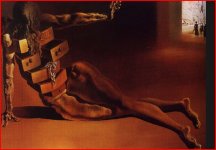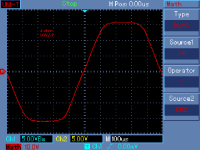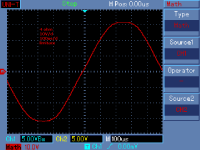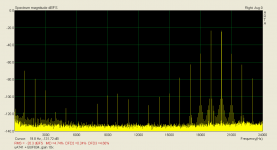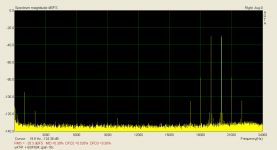That is a nice test !! -- more like real music being used and similar to a multi-tone test. Easier for anyone to try. Interesting results, too. Can you give more details about the amp topologies?
This info is present here (in russian)
??????? - ????????? ?????????? ????????? ?? ??????? ???????.
Main activity on this subject was in the years 1960-1970, among TV professionals. I suspect, that something wrong was with noise measurements, maybe clipping
You can do this measurement nowadays very simple, using e.g. ARTA, multitone signal, high decade. 13 tones from 2kHz to 20kHz. And observing band from 0 to 2kHz for IMD products.
But you will not find any special "X" distortion with noise or multitone signals, which are not easy detectable with ordinary measurements.
But you will not find any special "X" distortion with noise or multitone signals, which are not easy detectable with ordinary measurements.
You can do this measurement nowadays very simple, using e.g. ARTA, multitone signal, high decade. 13 tones from 2kHz to 20kHz. And observing band from 0 to 2kHz for IMD products.
But you will not find any special "X" distortion with noise or multitone signals, which are not easy detectable with ordinary measurements.
I think that multitone is not quite similar to white noise, the last is non-stationary with possible big peak-factor. Multitone is much more "pleasant" for correct operation of GNFB. Why not to try just white noise? It is closer to real musical signal.
Something close to white noise can be obtained from FM radio, just listenable noise at intermediate frequencies between the broadcasted frequencies.
Last edited:
the only problem
The average board has a few hundred, because an MLCC only costs five cents each.
On a non-average board, silicon caps would push retail up by five hundred bucks. But isn't that where the high-end tier fits in ?
I think that multitone is not quite similar to white noise, the last is non-stationary with possible big peak-factor.
Multitone is much more "pleasant" for correct operation of GNFB. .
In the past white noise was deep notched for these tests. High crest factor (e-5 and down probabilities) can clip which is not really what you are looking for and are so infrequent that they do not show up in any average measurement. As BV said a mutitone of sufficient length (and you can create any crest factor you want mathematically) will fully stress the system.
The second comment above is nonsense.
Multitone is much more "pleasant" for correct operation of GNFB.
A nice example of antropomorphisation (sp?) - the assignment of 'human' or even intelligent properties to inate matter.
jan
A nice example of antropomorphisation (sp?) - the assignment of 'human' or even intelligent properties to inate matter.
jan
Anthropomorphism.
Attachments
In the past white noise was deep notched for these tests. High crest factor (e-5 and down probabilities) can clip
It was the first issue I thought about when I read his post. As far as similar statements (like higher distortion of SS with white noise) are not immediately supported by measurements both in time and frequency domain, I would ignore them. As said by many, this is a fashion business with fashion business reasoning. Half true reasoning used in best cases.
We can see almost no scientific method and almost no scientific reasoning here. Mostly useless claims.
Maybe John could add something on white noise measurements, since his old results are widely mentioned in the literature
"The distortion specifications obtained for several operational amplifiers by a variety of test methods have been compared by Leinonen, Otala and Curl. (Ref.18). The t.h.d. at 1 kHz and the CCIF and SMPTE i.m.d. specifications were compared with the "noise-transfer” and "dynamic i.m.d.” tests.
The noise-transfer method uses an input signal consisting of filtered noise having a frequency range of 11 kHz to 20 kHz. The intermodulation products of this noise in the amplifier output in the 0 to 10 kHz range are measured and the ratio of the r.m.s. value to that of the input signal calculated.
The dynamic i.m.d test uses a low-pass filtered square wave and a high frequency sine wave with peak amplitude ratio of 4:1. A sine wave of 15 kHz was used and a 3.18 kHz square wave chosen for good separation between the sine wave, its harmonics and the intermodulation products. The total r.m.s. i.m.d. voltage is expressed as a percentage of the r.m.s. amplitude of the 15 kHz sine wave. The figure includes the dynamic i.m.d. components caused by the rise-time portion of the square wave.
The comparison of the methods showed that the CCIF, noise-transfer and dynamic i.m.d. figures gave good agreement in the order in which the tested amplifiers were placed. I.e. the amplifiers with the worst figures in one test method were also the worst in the others. The t.h.d. and SMPTE i.m.d. tests gave very low distortion levels in all the amplifiers tested. The same peak amplitude of output signal was used for each test method. e.g. The uA709 op-amp with unity gain compensation and 20 dB gain in the non-inverting mode gave less than 0.02 % t.h.d. at 1 kHz and 0.11 % SMPTE i.m.d. while the dynamic i.m.d. using a 30 kHz low-pass filtered square wave gave a figure of 62 %, the CCIF figure was 26% and the noise-transfer was 50 %. Clearly the 1 kHz t.h.d. and the SMPTE methods do not give a good indication of the levels of distortion under the other signal conditions."
"The distortion specifications obtained for several operational amplifiers by a variety of test methods have been compared by Leinonen, Otala and Curl. (Ref.18). The t.h.d. at 1 kHz and the CCIF and SMPTE i.m.d. specifications were compared with the "noise-transfer” and "dynamic i.m.d.” tests.
The noise-transfer method uses an input signal consisting of filtered noise having a frequency range of 11 kHz to 20 kHz. The intermodulation products of this noise in the amplifier output in the 0 to 10 kHz range are measured and the ratio of the r.m.s. value to that of the input signal calculated.
The dynamic i.m.d test uses a low-pass filtered square wave and a high frequency sine wave with peak amplitude ratio of 4:1. A sine wave of 15 kHz was used and a 3.18 kHz square wave chosen for good separation between the sine wave, its harmonics and the intermodulation products. The total r.m.s. i.m.d. voltage is expressed as a percentage of the r.m.s. amplitude of the 15 kHz sine wave. The figure includes the dynamic i.m.d. components caused by the rise-time portion of the square wave.
The comparison of the methods showed that the CCIF, noise-transfer and dynamic i.m.d. figures gave good agreement in the order in which the tested amplifiers were placed. I.e. the amplifiers with the worst figures in one test method were also the worst in the others. The t.h.d. and SMPTE i.m.d. tests gave very low distortion levels in all the amplifiers tested. The same peak amplitude of output signal was used for each test method. e.g. The uA709 op-amp with unity gain compensation and 20 dB gain in the non-inverting mode gave less than 0.02 % t.h.d. at 1 kHz and 0.11 % SMPTE i.m.d. while the dynamic i.m.d. using a 30 kHz low-pass filtered square wave gave a figure of 62 %, the CCIF figure was 26% and the noise-transfer was 50 %. Clearly the 1 kHz t.h.d. and the SMPTE methods do not give a good indication of the levels of distortion under the other signal conditions."
Pyccknn does not translate well of this. Pulsing tones and recording the fft from it may show the non musical factors and setting times . By using repeating tones the artifacts can be cover up . I think a pulse tone and record what is produced at the output. That can show cap overload gfb and a host of thing on the output.I think that multitone is not quite similar to white noise, the last is non-stationary with possible big peak-factor. Multitone is much more "pleasant" for correct operation of GNFB. Why not to try just white noise? It is closer to real musical signal.
Something close to white noise can be obtained from FM radio, just listenable noise at intermediate frequencies between the broadcasted frequencies.
The average board has a few hundred, because an MLCC only costs five cents each.
On a non-average board, silicon caps would push retail up by five hundred bucks. But isn't that where the high-end tier fits in ?
I am referring to digital designs here where you try and get one decoupler per power pin mainly on BGA devices, that is why you have so many. For standard decoupling of digital devices etc I would suspect no noticeable improvement to the circuit, for decoupling 8 leg devices (SMD) on critical analogue sections there may be a possibility of improvement. Where I can see their benefit is coupling caps in tight designs where the op-amps are in 0.5mm and 0.65mm pitch SMD packages, and other critical places, where COG values are just to small.
Maybe John could add something on white noise measurements, since his old results are widely mentioned in the literature
"The distortion specifications obtained for several operational amplifiers by a variety of test methods have been compared by Leinonen, Otala and Curl.
Please spare us going back to how poor 741's are in audio. At some point these historical perspectives deserve to remain footnotes and nothing more.
I call that weird.
(DALI is presume?)
or just a pun, "chest" of drawers?
Vladimir, in case of 'soft-clipping' like this (no GNFB amplifier) the borderline where distortion rises is not sharp. In case of white noise measurements, you will see lower distortion (in the transition area) because of smooth clipping. Anyway, it says nothing about quality of the amplifier.
Attachments
Please spare us going back to how poor 741's are in audio.
I am sure this is a hopeless wish
Attachments
Last edited:
- Status
- Not open for further replies.
- Home
- Member Areas
- The Lounge
- John Curl's Blowtorch preamplifier part II
